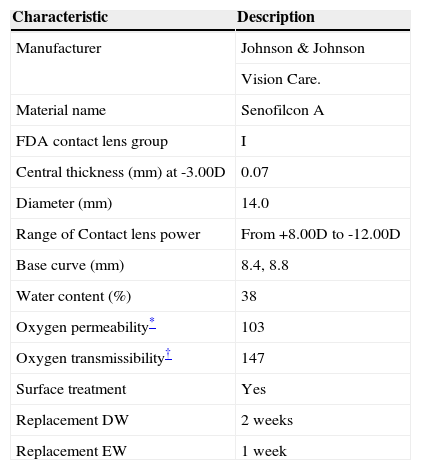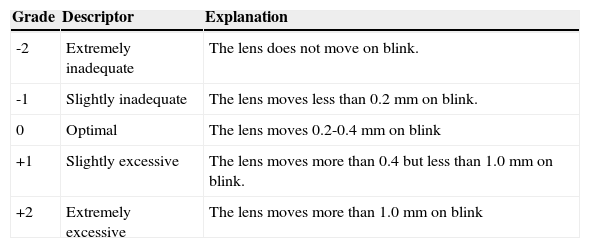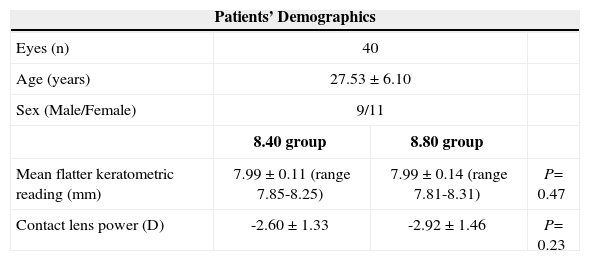To determine the influence of the base curve on the movement, on the corneal surface mechanical alterations and on the subjective comfort of Senofilcon A contact lens for corneas having central curve radius flatter than 7.80mm.
MethodsIn this prospective, double-masked, contralateral, randomized study, 40 eyes of 20 participants, with keratometric readings above 7.80mm, were randomly fitted with Senofilcon A contact lenses: one having an 8.80mm base curve in one eye and another one having 8.40mm base curve in the other eye. Lens movement, corneal surface mechanical alterations and comfort were assessed in both eyes 15 days after contact lens fitting.
ResultsAt 15 days of contact lens fitting, no statistically significant differences were found regarding lens movement between the lens with the 8.40mm base curve and the lens with the 8.80mm base curve. There were not statistically significant differences between groups neither in peripheral nor in central staining, and absence of clinical significance was found. There was a statistically significant difference on comfort rate between the lenses. The mean comfort score for the 8.80mm base curve was 3.5±0.92, whereas for the 8.40mm base curve it was 4.39±0.5 (P<0.001).
ConclusionsIn corneas with keratometry flatter than, 7.80mm, 8.80 and 8.40mm base curves, show acceptable fitting characteristics. Nevertheless, 8.40mm base curve is more comfortable than 8.80mm base curve. These results suggest that silicone hydrogel soft contact lenses may require steeper base curve selection criteria than the conventional hydrogel soft lenses in order to improve the comfort.
Determinar en qué medida influye el valor del radio base de la lente de contacto Senofilcon A en el movimiento de la misma, en las alteraciones mecánicas que causa en la superficie corneal y en el grado de comodidad subjetivo, en córneas con un radio de curvatura central mayor (más planas) que 7,80mm.
MétodosEn este estudio prospectivo, con doble enmascaramiento, contralateral y aleatorizado se analizaron 40 ojos (todos ellos con valores queratométricos superiores a 7,80mm) de 20 pacientes; a cada uno se le adaptó en ambos ojos lentes de contacto Senofilcon A: en un ojo designado aleatoriamente se le adaptó una con un radio base de 8,80mm, y en el otro ojo del mismo participante, una lente de contacto con un radio base de 8,40mm. Trascurridos 15 días de la adaptación de la lente de contacto, se evaluaron en ambos ojo el movimiento de la lente, las alteraciones mecánicas ocurridas en la superficie corneal y el grado de comodidad subjetivo.
ResultadosQuince días después de la adaptación de la lente, no se hallaron diferencias significativas entre la lente de 8,80mm de radio base y la de 8,40mm en lo que respecta al movimiento de la lente. Tampoco el fluorograma reveló diferencias estadísticamente significativas entre ambos grupos (ni en la zona central ni en la periferia de la córnea). De hecho, este examen no produjo ningún resultado con trascendencia clínica. Sí se obtuvo una diferencia estadísticamente significativa entre ambos tipos de lente en lo referente al grado de comodidad. El grado de comodidad promedio para la lente con 8,80mm de radio base fue de 3,5±0,92, mientras que para la lente con 8,40mm de radio base fue de 4,39±0,5 (P<0,001).
ConclusionesEn córneas con un radio de curvatura mayor que 7,80mm (más planas), tanto las lentes con 8,80mm de radio base como aquellas con 8,40mm de radio base presentan una adaptación aceptable. Sin embargo, un radio base de 8,40mm resulta más cómodo que el radio base de 8,80mm. Estos resultados sugieren que las lentes de contacto blandas de hidrogel de silicona podrían necesitar unos criterios de selección con un radio base menor (más pronunciado) que las lentes de contacto blandas de hidrogel convencionales, con el fin de aumentar el grado de comodidad.
During the evolution of soft contact lens fitting, base curve radius selection has been always a matter of concern. It has usually been selected based on the keratometric data obtained across the central 3mm of the cornea. A successful fitting results in an adequate distribution of the contact lens weight over all the corneal surface, leading to a right lens position, good centration and enough movement to have an optimal tear turn-over, all of which produces minimal mechanical effect between the eye and the contact lens.1 If the contact lens shape does not fit properly on the ocular surface, it will produce different pressure points and it could have clinical consequences.1 Despite this, some authors suggest that the actual frequent-replacement hydrophilic contact lenses, which are thin and have a low elasticity modulus, fit to the corneal topography independently of the chosen base curve.2-5
Newer generations of soft contact lenses are represented by the silicone hydrogel soft contact lenses (SiHySCL). The fitting of these new SiHySCL can reduce hyperemia, compared to the fitting of conventional soft contact lenses, and it can result in improvements regarding symptoms of dryness and discomfort.6 For this reason, these contact lenses are becoming increasingly popular among patients and practitioners. However, since SiHySCL have a higher elasticity modulus than conventional contact lenses, the adaptation between the lens and the eye is more difficult. Furthermore, as it has already been reported, the patient's perception of contact lenses7,8 depends greatly on the initial comfort during trial fitting, which may have an effect on the ultimate success of contact lens wear. Therefore, one may think that these contact lenses would require more precision in the selection of the geometric parameters than conventional soft contact lenses in order to achieve a good fitting. For this reason, Johnson & Johnson (Vision Care, USA) has introduced the new Senofilcon A SiHySCL, with a flatter base curve (8.80mm) to be fitted on corneas having a flatter central curve radius.
The purpose of this study was to investigate the effect of lens base curve on subjective comfort, on corneal surface mechanical alterations and on the movement of Senofilcon A SiHySCL in corneas having a central curve radius higher than 7.80mm.
MethodsWe conducted a prospective, double-masked, randomized and clinical comparative study. Forty eyes of 20 participants, previous contact lens wearers, were included in this trial. Participants were randomly fitted (using a portable pseudorandom number generator9) with a Senofilcon A contact lens of 8.80mm base curve in one eye and with an 8.40mm in the other eye. This study was performed at the European University of Madrid. The tenets of the Declaration of Helsinki were followed and full ethical approval was obtained by the European University of Madrid. Informed consent was obtained from all participants after a full explanation of the nature and possible consequences of the study.
Inclusion criteria for the participants were: central corneal radius flatter than 7.80mm, aged between 18 and 40 years, soft contact lens wearers who had not had any complaints, spherical refraction ranging from -0.50D to -9.00D and astigmatism <0.75D. Exclusion criteria included corneal disease, previous ocular surgery, the use at the time of the study of systemic or topical medication that could affect ocular physiology or the performance of the contact lenses, neuro-ophthalmic disease and history of ocular inflammation.
Participants underwent a full ocular assessment. Next, a Senofilcon A contact lens of either 8.80mm or 8.40mm base curve was randomly fitted in each eye of every patient. Table 1 shows the characteristics of the contact lens.
Characteristics of the contact lens used in the study
| Characteristic | Description |
| Manufacturer | Johnson & Johnson |
| Vision Care. | |
| Material name | Senofilcon A |
| FDA contact lens group | I |
| Central thickness (mm) at -3.00D | 0.07 |
| Diameter (mm) | 14.0 |
| Range of Contact lens power | From +8.00D to -12.00D |
| Base curve (mm) | 8.4, 8.8 |
| Water content (%) | 38 |
| Oxygen permeability* | 103 |
| Oxygen transmissibility† | 147 |
| Surface treatment | Yes |
| Replacement DW | 2 weeks |
| Replacement EW | 1 week |
D= Diopters
DW: daily wear
EW: extended wear.
Lens movement, corneal surface mechanical alterations and comfort were assessed in both eyes 15 days after the fitting of the Senofilcon A SiHySCL, and at least 8hours after lens insertion. The criteria for assessing lens movement are shown in Table 2. Limbal conjunctival staining and corneal staining were graded using the Efron grading scale.9 Corneal staining was graded after approximately 90s of a single instillation of fluorescein sodium (Fluorets; Chauvin Pharmaceuticals Ltd, Essex, UK). A cobalt blue filter in the illumination system and a yellow fluorescein enhancement filter (Kodak Wratten no. 12; Eastman Kodak, Rochester, NY, USA) over the objective lens were used in the assessment of corneal staining. Comfort was recorded using a scale from 1 to 5 (1 extremely uncomfortable, 2 uncomfortable, 3 comfortable, 4 very comfortable and 5 extremely comfortable).
Criteria for assessing the lens movement
| Grade | Descriptor | Explanation |
| -2 | Extremely inadequate | The lens does not move on blink. |
| -1 | Slightly inadequate | The lens moves less than 0.2mm on blink. |
| 0 | Optimal | The lens moves 0.2-0.4mm on blink |
| +1 | Slightly excessive | The lens moves more than 0.4 but less than 1.0mm on blink. |
| +2 | Extremely excessive | The lens moves more than 1.0mm on blink |
Data analysis was performed by means of SPSS for Windows, version 14.0 (SPSS Inc., Chicago, IL). Normality was checked by the Shapiro-Wilk test. Comparisons regarding lens comfort, lens movement, limbal conjunctival staining and corneal staining were all carried out by means of the chi-square test. Differences were considered to be statistically significant when the P value was <0.01.
ResultsForty eyes of 20 participants were included in this trial. Table 3 shows the participants’ demographics. There were no statistically significant differences, neither in keratometry nor in contact lens power, between the eyes fitted with the 8.40mm base curve lens and the eyes fitted with the 8.80mm base curve one.
Demographics of patients. Age, sex, flatter keratometric reading, and contact lens power shown as means and standard deviation (SD)
| Patients’ Demographics | |||
| Eyes (n) | 40 | ||
| Age (years) | 27.53±6.10 | ||
| Sex (Male/Female) | 9/11 | ||
| 8.40 group | 8.80 group | ||
| Mean flatter keratometric reading (mm) | 7.99±0.11 (range 7.85-8.25) | 7.99±0.14 (range 7.81-8.31) | P= 0.47 |
| Contact lens power (D) | -2.60±1.33 | -2.92 ± 1.46 | P= 0.23 |
No statistically significant differences were found regarding lens movement between the 8.40mm base curve lens and the 8.80mm base curve lens (P=0.27). For 19 out of 20 eyes in both groups (95%) the corresponding lens movement was found to be from slightly excessive to slightly inadequate (i.e; grade 0, 1 or -1). Moreover, 12 (60%) and 11 (55%) out of 20 eyes, corresponding to the 8.40mm and to the 8.80mm base curve lens group, respectively, showed optimal lens movement characteristics (i.e; grade 0; see Table 4).
Limbal conjunctival staining grade 1 appeared in 3 cases for the lens of 8.80mm radius and in 3 cases with the lens of 8.40mm radius. Only one case had corneal staining grade 1 with the lens of 8.80mm radius. No more statistical analyses were made because of the absence of clinical significance.
There was a statistically significant difference on comfort rate between the two groups. The mean comfort score for the 8.80mm base curve lens group was 3.5±0.92, whereas for the 8.40mm base curve group it was 4.39±0.5 (P<0.001). 55.6% of the participants gave a score of 4 or 5 (i.e; very comfortable or extremely comfortable) to the 8.80mm base curve lens, while 100% of the participants gave a score of 4 or 5 to the 8.40mm base curve lens, with (P<0.001) (see Figure 1).
DiscussionSeveral reports have shown that the new SiHySCL have eliminated most hypoxia-related complications.11-14 However, the fitting of these SiHySCL may be more complicated; because they are made of a more rigid material than conventional hydrogel lenses and, therefore, the adaptation between the lens and the eye might be more sensitive to base curve radius variations. Johnson & Johnson Vision Care (Jacksonville, FL, USA) has recently introduced a new Senofilcon A SiHySCL contact lens with a flatter base curve (8.80mm) to fit on corneas having flatter central curve radius. In the present study we have assessed the influence of the base curve on the fitting and comfort of the Senofilcon A SiHySCL on corneas having a central curve radius higher than 7.80mm. To the knowledge of the authors, this is the first study that has evaluated two different curvature radii of the Senofilcon A SiHySCL (8.40mm and 8.80mm) for a sample of corneas with keratometric readings flatter than 7.80mm. This has allowed us to test the influence of the curvature radius on comfort and fitting characteristics. Due to this reason, we do not compare our results with others reports.
In our study, no differences were found regarding lens movement between the two contact lenses. Nineteen of 20 eyes in both groups showed optimal to slightly inadequate lens movement characteristics. This is not surprising: in our study we only measured the central corneal curvature, but it has been shown that this parameter is not as important for the fitting of a SiHySCL as it is in the case of conventional soft CLs, since due to their thinner geometry a good adaptation to the sclero-corneal curve shape is achieved more easily. Other parameters, including corneal diameter, asphericity, and sagittal height, have proven to be more useful to predict the fit of thinner-lens designs.15-17
There were not any statistically significant differences between groups in terms of limbal conjunctival staining and corneal staining, and absence of clinical significance was found. Our results suggest that mechanical alterations are not influenced by the base curve of the Senofilcon A SiHySCL when the lens is fitted on corneas with curve radius higher than 7.80mm. Therefore, one may argue that the specific value of the base curve has a low influence on the mechanical effect of this contact lens on the corneal surface.
In our study, there was a statistically significant difference in comfort rate between the lenses. Participants preferred the lens with the 8.40mm base curve. The mean comfort score for the 8.80mm base curve was 3.5±0.92 and for the 8.40mm base curve it was 4.39±0.5 (P<0.001). 55.6% of the participants rated the 8.8mm base curve lens as very comfortable or extremely comfortable, whereas 100% of the participants rated the 8.4mm base curve lens as very comfortable or extremely comfortable (P<0.001; see Figure 1). A previous clinical trial18 had shown that when silicone hydrogel lenses are too flat relative to the corneal curvature, the result is often a lens that exhibits edge lift or slight fluting that causes foreign-body-like discomfort for the patient, this previous clinical trial was carried out only with 8.6mm base curve lotrafilcon A lenses. No direct comparison with previous studies focused on evaluating two different curvature radii of the Senofilcon A SiHySCL (8.40mm and 8.80mm) for a sample of corneas with keratometric readings flatter than 7.80mm was possible, because this is the first study that has compared this two lens designs. However, there is one previous study that is interesting to discuss. Dumbleton et al.19 evaluated the effect of base curve on subjective comfort in ninety-five subjects who were first trial fitted with 8.6mm base curve lotrafilcon A lenses and then with 8.4mm lenses only if poor subjective comfort or poor fit was revealed. The authors reported that 45 out of 190 eyes (23.7%) required 8.40mm lenses due to poor subjective comfort with the 8.6mm lenses. The mean comfort score for those subjects rose from 6.33 with the 8.60mm lens up to 9.44 with the 8.40mm lens. Although these authors also found that the contact lens with steeper base curve was more comfortable, differences between the two studies should be taken into account. In the Dumbleton et al.19 study, the mean flatter keratometric readings of the eyes that were fitted with a 8.4mm base curve lens due to poor subjective comfort with the 8.6mm one was 7.55mm (range, 8.04 to 7.22mm). These authors used lotrafilcon A lenses and, in this previous study, the flatter curve base lens was steeper than that used in our study (8.60mm vs 8.80mm). On the other hand, this previous study only examined the comfort 15minutes after lens insertion, while in our study the comfort was assessed in both eyes 15 days after the fitting of the Senofilcon A SiHySCL.
One limitation of the present study, is the relatively limited sample size used and the short follow-up time, which does not allow us to confirm the absence of complications when fitting steeper contact lenses on relatively flatter corneas in order to improve short-term comfort. This aspect should be further investigated.
In summary, our results suggest that in corneas with keratometric readings flatter than 7.80mm, both the 8.80mm and the 8.40mm base curve Senofilcon A SiHySCL show acceptable fitting characteristics and seem to have no influence on the mechanical alterations. Nevertheless, the 8.40mm base curve lens is more comfortable than the 8.80mm base curve one. These results suggest that silicone hydrogel soft contact lenses may require steeper base curve selection criteria than the conventional hydrogel soft lenses in order to improve the comfort. Futures studies should include a larger sample and long-term studies should be carried out to asses the possible complications that a stepper fit with these contact lenses may cause.
The authors have no proprietary interest in any of the materials mentioned in this article.














